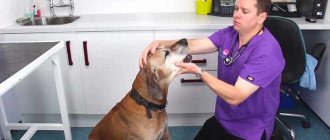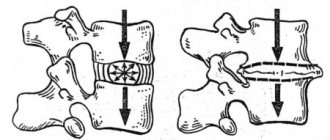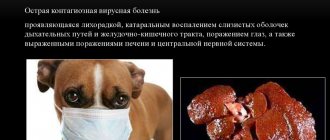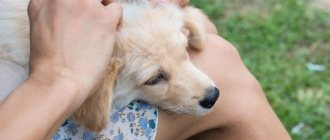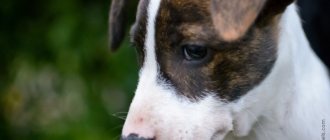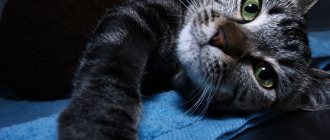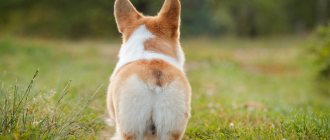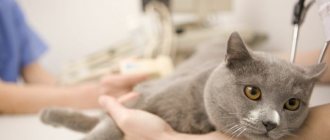Umbilical hernia in dogs is a fairly common occurrence. An animal may have a congenital pathology or an acquired one. Treatment of umbilical hernia in dogs is impossible; the only way out is reduction and suturing. The problem cannot be underestimated; a hernia is fraught with serious complications, including death. In this article we will talk about the causes of umbilical hernias in dogs of puppyhood and adults. Let's look at the types of such hernias and learn what to do if a problem arises.
What is an umbilical hernia?
This is a pathology in which the animal's insides - the bladder, uterus, omentum and intestines - fall out of the umbilical ring - an opening in the abdomen called the navel.
This condition is not always due to genetic predisposition. The abdominal muscles can weaken and the umbilical ring opens for many reasons. First of all, we will consider the causes of the disease in puppies, and then in adults.
Why do puppies develop umbilical hernia?
It is believed that the occurrence of the disease directly depends on the course of pregnancy and childbirth in the dog, as well as on the method of cutting the umbilical cord. It's not like that at all. Throughout pregnancy, puppies inside the dog's womb receive all the substances they need for life through the umbilical cord. When there is very little time left before birth, the umbilical ring - the place where the umbilical cord attaches to the tummy - begins to narrow. The baby’s entire body is preparing to receive on its own not only food, but also oxygen. You need to learn to breathe, so contractions of the peritoneum begin. But this is not a factor in the development of a hernia, it’s a matter of genetics.
At birth, the umbilical ring is still open, but within 24 hours it should shrink completely. If the ring has an irregular shape or the tone of the abdominal wall is weak, then an umbilical hernia may form in the dog in these very first days of life.
How to identify a hernia in a puppy?
If the owner of the woman in labor is attentive and caring, then he will regularly examine the babies. You do not need to be a qualified veterinarian to identify an umbilical hernia in a dog or newborn puppy. With pathology, a more convex area is noticeable on the tummy than the rest of the area. There will be a small, protruding ball on the skin.
Don't start panicking right away. Umbilical hernias often occur in puppies, and in almost all of them they disappear on their own over the next few days of development.
Which breeds are more susceptible
There are no differences between purebred and outbred cats and dogs. Both the highest-bred offspring of multiple prize-winners and “nobles” picked on the street can easily get the defect. Since the defect is caused by genetic pathologies, it can be found in kittens and puppies of any breed.
Causes of umbilical hernia in older dogs
If the problem arose in puppyhood, then the cause is a weak umbilical ring, and this is a congenital pathology. In adults, the problem may arise for other reasons.
- Peritoneal injuries, overload - do not force the dog to perform physical exercises by force, everything should be in moderation.
- Umbilical hernia in dogs after surgery is a common occurrence. The complication occurs due to an insufficient recovery period. Immediately after the sutures are removed, the animal cannot be loaded in the same way as before the operation, it must become toned, do not disregard the veterinarian’s recommendations for recovery, follow all instructions and rules.
- Frequent and multiple pregnancies of the dog. This problem often occurs when the dog walks on its own and the owner does not keep track of the mating. Another risk group is an inexperienced breeder who wants to make money on the fruiting of his pet, without caring about her condition. If you breed a breed, then take the dog the recommended number of times a year; after one pregnancy, you cannot immediately take it to the groom again. If you don’t want to breed animals, then it’s better to sterilize your pet, this is the key to its health and your peace of mind.
- Frequent constipation. This may be due not only to poor nutrition, but also to intestinal pathology. If you notice such a problem, the first thing you need to do is contact your veterinarian. If no diseases are found, then completely review your pet’s menu; if necessary, put it on a diet.
- The cause of a hernia can be another disease - ascites.
- Persistent bloating.
- High pressure inside the peritoneum.
If the owner himself can determine the penultimate factor by the frequent “gas contamination” of the room, then only a veterinarian can determine the latter. It is precisely because of frequent disturbances in the functioning of the body, invisible to the eye, that dogs must be taken to the veterinarian annually for examination. The animal cannot say where, what and how it hurts, and often does not even show its abnormal condition.
Types of umbilical hernias
Photos of an umbilical hernia in dogs can be seen in this material. This is a very common phenomenon, and some animals can live with this feature all their lives, while eating well, exercising and not showing pain, since there may not be any pain at all. This may be due to the growth of the omentum to the hernia; it does not fall out, but does not fall into place, it protrudes a little, which may be completely unnoticeable. In this state of affairs, the hernia can be left untouched; the dog will live without noticing the pathology throughout his entire happy canine life. Another thing is when an umbilical hernia appears in a dog with prolapse of the omentum, in this situation it is necessary to correct the pathology, suturing, narrowing, the umbilical ring. But about the operation later, let's look at the types of hernias in dogs of all ages.
If a bump appears on the tummy of a newborn, this is not a reason to make a diagnosis. Hernias are of the following types:
- A true hernia is a type of pathology in which the umbilical ring opens and some part of the organ passes through it. The most common organ that protrudes is the intestine.
- A false hernia is a type in which the navel ring opens, but organs do not pass through it, remaining in the correct position in their places. The skin pouch becomes soft due to filling with fatty tissue. With this type of hernia, the hernia is very mobile.
- A moving hernia is a type of pathology in which you can easily push the prolapsed organ back inside by slightly pressing the sac. The gate - the umbilical ring - does not prevent the reentry of the organ.
- A hard or immovable hernia is the most dangerous type of pathology, in which the umbilical ring, after prolapse of the organ, sharply narrows and remains in that position. In this condition, an internal organ becomes pinched.
Briefly about the main thing
- Hernias can be congenital - due to improper development of the fetus, or more often hereditary, and acquired - after injury or surgery.
- There are umbilical, inguinal, perineal, diaphragmatic, intervertebral and hiatal hernias, which mainly differ from each other in their location.
- Most often, the only effective treatment is surgery.
- Hernias are diagnosed not only visually, but using special research methods - radiography, ultrasound, endoscopy, etc.
- After surgery, it is important to limit the dog’s movements and provide a special diet.
Hernia dimensions
If a small bump appears in the navel area of even an adult animal, you should urgently show your pet to a veterinarian. It is not a fact that the hernia will remain this size; it can grow to the size of a lemon or a chicken egg, depending on the size of the dog and the tone of the umbilical ring. This may not happen at all; the dog will live its entire life without knowing about the pathology. Or it can happen differently - the hernia will “grow” sharply even with a small load, pinching will occur and the pet will simply die within a few hours.
A lump in the navel area does not always indicate a hernia. It could be a harmless wen or a dangerous cancerous tumor. In any case, the pet should be shown to a doctor, even if it does not show signs of an uncomfortable condition.
Symptoms
Symptoms of various types of hernias are presented in the table.
| View | Symptoms |
| Inguinal | It is characterized by the appearance of a pouch-like formation in the groin. It is not painful. When pressure is applied, the animal experiences involuntary urination. |
| Perineal | The consistency of a perineal hernia is soft. Location: in the perineal area. |
| Intervertebral | Main symptoms: · careful gait; · no sudden movements; · lack of coordination. |
| Diaphragmatic | There is heavy breathing, severe salivation, and shortness of breath. |
| Umbilical | Symptoms may include:
|
Why are hernias on the navel dangerous?
Veterinarians recommend that the hernia be repaired without fail, and the sooner this happens, the less risk there is to the life and health of the animal. Even if a puppy has a formation, you should not expect it to resolve on its own. The reason for this is obvious - the umbilical ring can close at any time, and the contents of the skin sac will be pinched. Why is this dangerous?
- When the intestines are pinched, vomiting begins first and the dog suffers from constipation.
- If the pinching has absorbed part of the bladder, stagnation of urine will begin, which will lead to kidney failure.
- When pinched, a dog experiences severe pain.
- Blood circulation is impaired.
- Blood does not flow into the pinched part, a lack of oxygen begins, and the tissues pinched by the ring begin to die.
- Dead tissue disintegrates, which causes intoxication of the body.
- If no measures are taken, the dog will fall into a short coma and then die.
If the necrotic process has begun, then the animal owner will have a matter of minutes to deliver the pet to the clinic, and there he will immediately go to surgery, where the umbilical hernia will be removed.
Dogs with a false hernia do not require surgery; it is not dangerous to health unless the dog himself begins to scratch it and injure it.
Treatment regimen
The duration and treatment algorithm should be judged by the type of hernia and the age of the dog.
If you have a lump on your stomach, you must consult a doctor for examination.
The doctor determines the degree of development and type of disease in the animal by examination or ultrasound.
Treatment of reducible small sizes can allow non-intervention of the surgeon only in very small puppies. If the lump is insignificant and is pressed in with a finger, the doctor will prescribe a special bandage for the pet, which will compress the abdomen and prevent it from falling out. Such treatment will only help if the doctor is confident that the ring will tighten on its own.
In the case of a strangulated hernia, the pet will not survive without surgery.
The operation does not last long and is not complicated, however, it is done under general anesthesia.
Diagnostics
If the condition is not acute, the dog does not show its condition in any way, or the symptoms are weak, but the owner has already brought the pet to the clinic, he will be immediately sent for an ultrasound. After this, you will need to donate blood for analysis to make a more accurate diagnosis.
In case of an acute condition, there is no time to waste. Without prior diagnosis, the dog will be immediately referred to a surgeon.
Surgery to remove an umbilical hernia in a dog
There's nothing wrong with that. If the organs have not come out through the ring, then the doctor will simply straighten the abdomen carefully and suture the hernial orifice.
If there are organs in the bag, then first you will have to open this bag to check the condition of these organs. If there are no injuries or other problems, then they are also reduced, and the surgeon sutures the gate.
If there was pinching, then there is a high probability of tissue death. In this case, they are removed and cleaned, which is dangerous for the life of the animal. Only then will the doctor realign the organs and suture the gate.
There will be no relapses after the operation. Once recovered, the dog will begin to live its normal life.
Actions at home
If an umbilical hernia appears in a dog, every owner should know what can and cannot be done.
Under no circumstances should you try to correct the pathology yourself. Your actions can lead to complications - pinching or even rupture of organs. Do not do anything other than contact your doctor.
After surgery, the dog will need a warm, dry place in the house. The wound will need to be treated with disinfectants. The veterinarian will prescribe a diet that you must adhere to! Buy your animal a bandage so that when he stands up, his stitches do not come apart.
Caring for a sick animal
After the operation, the veterinarian prescribes anti-inflammatory antibiotics and mild painkillers in the form of injections. Rehabilitation after removal is quick.
You can speed up the healing of the suture with special ointments that disinfect, relieve swelling and inflammation.
In some cases, immunostimulants are prescribed to quickly restore health.
There can be no relapse of the disease after surgery. However, for preventative purposes, it is better to visit a veterinarian regularly for examination.
A number of vitamins and medications that support intestinal microflora must be included in the dog’s diet during treatment and rehabilitation.

